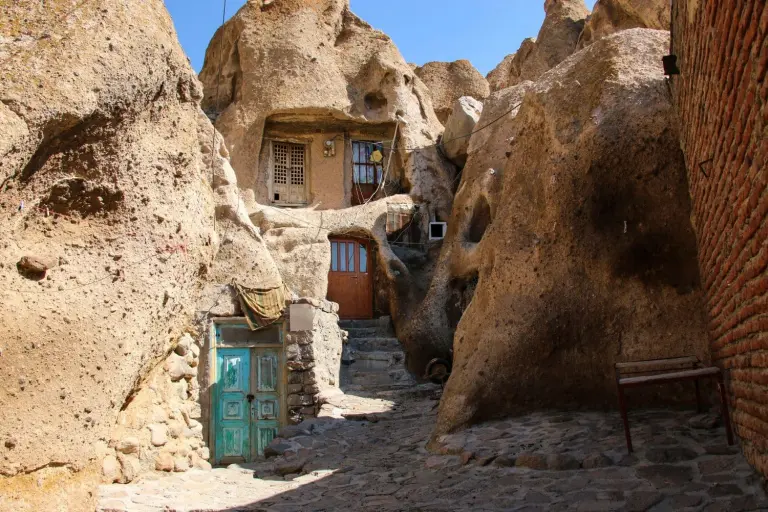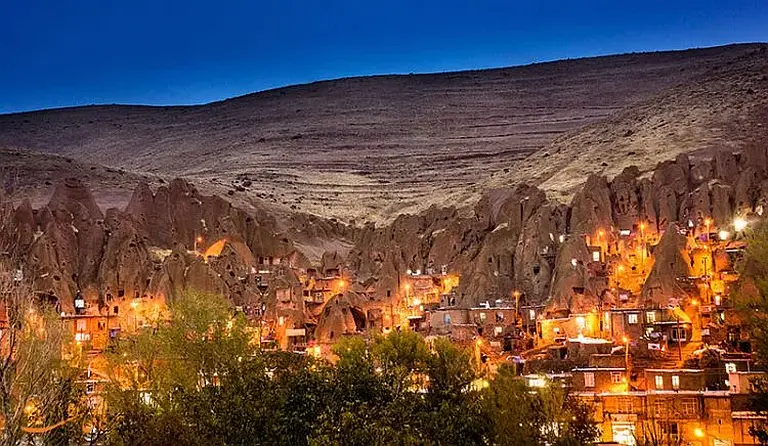Tabriz is one of the five largest cities in Iran and a must-visit destination for travelers exploring this country. Located 599 kilometers from Tehran, Tabriz is the most important city in northwestern Iran. If you visit this historic city, don’t miss Kandovan, the ancient rock village nestled in the Sahand Mountains, 60 kilometers from Tabriz.
In addition to Kandovan, Tabriz offers many other famous attractions worth visiting, such as the Tabriz Bazaar Complex (a UNESCO World Heritage Site since 2010), the world-renowned carpet market, the Blue Mosque, Shah-Goli Park, and the Mashrouteh Museum.

The “Beehives” of Kandovan
Kandovan village lies on the Sahand Mountains, 60 kilometers from Tabriz. On the journey there, you’ll encounter breathtaking natural scenery, with remnants of winter lingering as patches of melting snow on the mountain slopes. To maintain the serene ambiance of the village, large vehicles are prohibited from entering. Visitors can walk and watch the massive beehive-like structures gradually emerge against the crisp, late-winter morning air.

The name Kandovan has several interpretations, but one common explanation in Persian is that it means “beehives,” derived from the words “kando” (beehive) and “an” (a plural suffix). The village symbolizes a lifestyle harmoniously integrated with nature. From afar, Kandovan appears as clusters of houses carved into conical rock formations with jagged peaks, resembling a giant beehive. This unique geology resulted from volcanic eruptions and weather erosion over 10,000 years ago. These rock homes remain cool in summer and warm in winter. They are often two-story structures, with the ground floor used for keeping livestock like sheep or horses, while the upper floor serves as the family’s living area.
The residents of Kandovan, like most people in Tabriz province, speak Azerbaijani Turkish, one of the most widely spoken dialects in Iran. This language is nearly identical to the Turkish spoken in Turkey and Azerbaijan. Knowing Turkish is advantageous here; for example, our Turkish-speaking friends helped us save 2000 toman when buying a handmade bag. However, you don’t need to worry much—outside of the carpet market, prices in Tabriz are usually fixed, as sellers tend to quote fair prices.

Kandovan has existed for over 700 years, with some homes dating back to pre-Islamic times, more than 14 centuries ago. According to our guide, the village served as a refuge for locals during the Mongol invasions of Iran. Today, it remains home to nearly 1,000 people and is one of the key attractions for both domestic and international tourists visiting Tabriz.
Kandovan is one of only three rock-carved villages in the world, alongside Cappadocia (Turkey) and Dakota (USA), but it is the only one still inhabited. Residents continue their traditional way of life, living alongside livestock and engaging in activities such as carpet weaving, animal husbandry, beekeeping, harvesting medicinal herbs, and participating in tourism.

Like most Iranians, the people of Kandovan are known for their hospitality. They warmly welcome visitors, sharing the history of their village with pride and passing this passion down through generations. This dedication has helped preserve the village remarkably well to this day.
Water and Honey
When visiting Kandovan, many locals and domestic tourists bring home bottles of mineral water sourced from the village’s natural springs. The villagers proudly claim that the water is exceptionally light and beneficial for treating kidney stones. Visitors often carry their own plastic bottles to fill with this spring water, while the locals also prepare extra bottles for those wanting to take some of this natural gift home.

Kandovan is also famous for its honey and forest herbs. These local products, along with traditional handicrafts, are sold in the rock-carved homes. Kandovan honey is renowned across Iran and is a prized souvenir for visitors to bring home for friends and family. Prices range from 10,000 toman to 20,000 toman per kilogram.
While honey is a common food item in Iran, honey harvested from high-altitude regions like Kandovan or Tabriz is considered far superior to that from other areas. Visitors can sample various types of honey to find their favorite without any concern about upsetting the sellers.

Since 2005, a five-star hotel has been operational in Kandovan, designed to replicate the traditional rock-carved homes. All the rooms are constructed and furnished to provide guests with an authentic experience of life in this rock village. For a more intimate experience, visitors can also stay with local families, where they will be warmly welcomed and served traditional Iranian and Tabriz dishes.
While tourism has brought changes to Kandovan, local authorities and residents are striving to preserve its ancient charm and cultural traditions.







